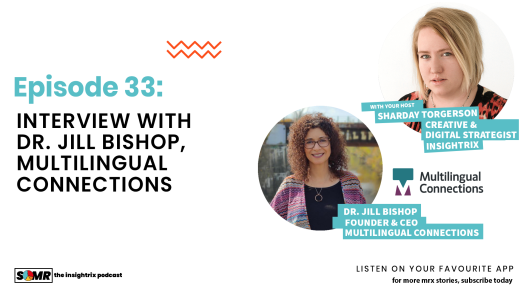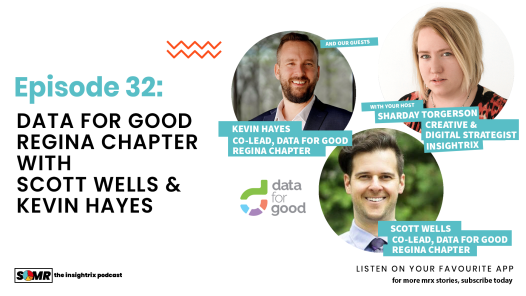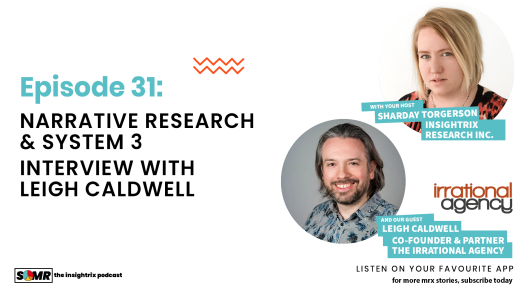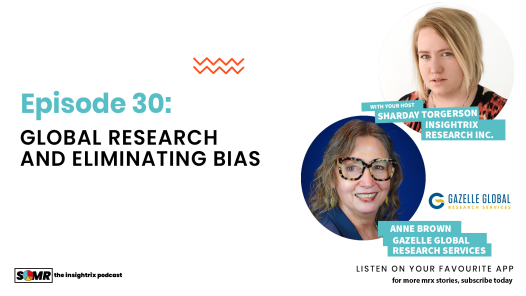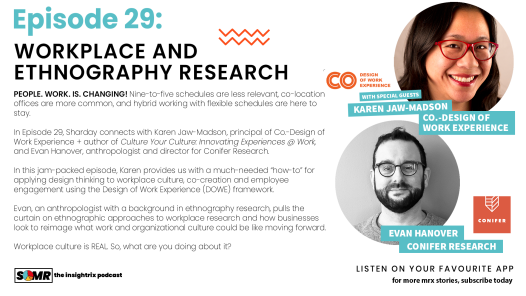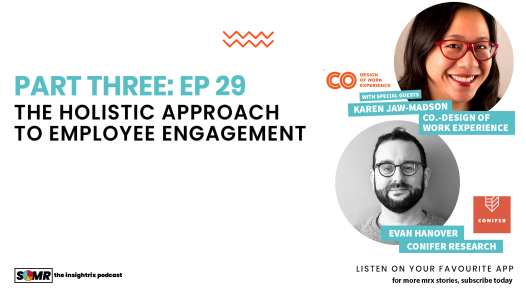Sharday:
I’m really excited to talk about organizational culture with you beautiful people but before we jump in, please let me welcome you both. Please let me welcome Karen Jaw-Madson, principal of Co-Design of Work Experience, author of Culture Your Culture: Innovative Experiences @Work. Karen is an advisor, a consultant, a coach, an author, a speaker, and an educator. And is known to be a versatile leader across multiple industries with the experience leading in implementing organizational cultures, initiatives around the globe. Welcome, Karen, it’s nice to have you.
Karen:
Thank you. Thanks for having me.
Sharday:
And then of course, we’ve been just talking up a storm beforehand so it’s kind of an odd one that we’re going back and kind of introducing ourselves when we’ve been already having a time, so. But I would also like to welcome Evan Hanover. He is the research director at Conifer Research in Chicago, Illinois. And with a masters of anthropology and an expert in consumer research, Evan is known to explore human behavior holistically and at an eye level.
Sharday:
I am Sharday Torgerson, the creative and digital strategist here at Insightrix Research in Saskatoon, Canada, and your season three host of the Stories of Market Research, the Insightrix Podcast. Now, listen this topic is fully loaded and fully baked for our listeners. And I literally cannot wait to dive in but I think before we get too deep into it, I want to talk a little bit about organizational culture. Now I think the whole term is kind of fun to throw around in a room of people and attempt to get everyone to kind of agree with what exactly culture, workplace culture, organizational culture, corporate culture, what have you, it is. Now, I’m going to leave this open for discussion for everyone but I’m curious, what are we talking about when we’re talking about work culture? And really what we’re talking about is when we’re talking about the realness behind everything is done in business. What are we meaning when we say workplace culture is real?
Evan:
Well, Sharday, thanks for having us. You’ve asked a question that has been plaguing my discipline in anthropology well, since its inception. I don’t think there’s a single agreed-upon definition of what culture is and I don’t get too hung up on that. But I think there is a lot to be learned and a lot of benefit to be had by going beyond simply saying we’re an innovative culture, we’re a startup culture, we’re an entrepreneurial culture. I think what culture is, is all of the background practices, values, traditions, language that exist within an organization that kind of shape people’s interactions, shape their expectations, help shape their collaboration, help shape the way they see their future and their trajectories within a given workplace. And the reason I love doing organizational culture work is that organizational cultures are fully realized. There are little rights and rituals that go on whether it’s simply I don’t know, a Friday afternoon happy hour to help bond people. The daily gossip by the coffee machine, the proverbial water cooler but there are interaction types.
Evan:
There is the formal office meeting interaction. There’s the all-hands meeting interaction. There are the informal interactions that go on in the hallway or more likely now on Slack or Zoom, stuff like that. There is language and jargon that marks people as longstanding members of a company and newbies or outsiders they are the espoused values. There are how those values are actually play out on the ground. Like I said, there’s those life trajectories, there’s sort of statuses and political relationships. All of the things you find outside of an in-person or virtual corporate office like out in the world when we think about culture, all exist within companies. And all of that goes to affect how people perform and stay engaged, stay employed at a given company. Which we’ll get into I have a feeling, quite a bit. Now it’s you Karen it’s a totally different definition.
Karen:
No, it’s not totally different.
Sharday:
I’m curious.
Karen:
I think Evan, no, it’s not completely different. We just have our ways of defining it and that’s because you’re right, Evan. There is no universally accepted definition and so therefore when we all do our work and this is a great idea for you that Sharday actually asked us to start here because it’s important to state it upfront so we know what we’re talking about. Right? From my perspective, and I’m just going to layer on top of what Evan said, culture is this social construct and it’s reflected in all the things that have the power to influence behaviors, interactions, people’s perceptions. And it really communicates what’s acceptable and not acceptable and it shows up in how people behave, interact, react, and perceive reality, right. It’s something that’s created and reinforced and experienced.
Karen:
And this is where I really see, I resonate with Evans’ definition is the experience of culture. It’s not what people say it’s really what people do and what they live through. And so, if you look at what those social boundaries look like, therein lies your culture, right. And so there’s a lot of misconceptions about it out there and I could talk all day about it but I think what’s really important when we’re talking about organizations is that it’s either an asset or a liability whether or not you’re paying attention to it. And so that’s kind of my soapback.
Sharday:
Absolutely.
Karen:
I’m going to get on that soapbox probably a few times here but that’s the big thing is that it’s not always cultural-led in organizations when in fact it should be. Because it’s the thing behind everything, in my opinion.
Sharday:
Yeah. [inaudible 00:06:35].
Evan:
Yeah, I think there’s one more. There’s a lot more aspects to it but the other thing is it’s dynamic. Culture is not an artifact. It isn’t frozen in time. And Karen talked a little bit about how it’s lived, it’s embodied, and it’s practiced and because it’s practiced it is sort of constantly out there and being iterated on in the world. And a lot of those changes might not be perceptible but some of them are bigger and you see them if there is some sort of scandal. A company is sort of refocused on culture when there’s a leadership change. And it so happens when there is a pandemic and people become dispersed because culture is also often practiced and embodied and reproduced in a space. And so when that space fundamentally changes, all of the other things fundamentally change, which I think is a lot of what we’re going to talk about today is understanding that change. But it’s important to know that this is something that it’s alive.
Karen:
It absolutely is. It’s organic, it’s evolving and this is the thing Evan, I wish people didn’t have this perception that culture was happening to them. We’re all part of that ecosystem and we’re contributing to and engaging with and shaping it through our own scope of influence. A lot of the work I do is trying to have people feel empowered to be and participate and to lead in the cultures within their organizations rather than saying, oh gosh, it happened. And it’s doing this to me and I can’t change it. I can’t touch it. Go ahead, Evan.
Sharday:
Yeah. Please, please continue on.
Evan:
I think that’s an interesting point about people exteriorizing it and saying it’s something that’s out there because this has happened in every project I’ve done on organizational culture and I suspect this will resonate with Karen as well. Which is that people talk about, let’s say you’re working for what’s the stereotypical? Acme company. People will say that’s the Acme way. I think it’s very common for people to explain away potentially negative behaviors by saying that’s the Acme way if we’re in a wily coyote organizational culture study. That people will say, this is the Acme way and it’s out there but it’s not that it’s your fault but you’re living the Acme way. You contribute to the Acme way and I think understanding that it is top-down bottom-up, left to right right to left is really important for not only understanding it but then trying to figure out how do you harness it and change it in a positive way?
Sharday:
I like that. If I may, I think we’re talking about two, almost workplace culture needs to happen from the background and into the forefront. I mean, let’s continue to roll on that so workplace culture really needs to happen from the background to the forefront, right? What does that look like when businesses are really implementing something like that? I mean, even on a high level, surface level we’re in a perfect world or what does it look like when businesses aren’t contributing their organizational culture from the background to the forefront?
Evan:
I think one of the things that you need to do is recognize that the background isn’t always articulatable, right. You can’t always explain culture. We already talked about how we couldn’t really define it that well. I mean, I think we were able to identify a lot of the markers that work together but explaining how the whole works in any concise way is a long and actually probably at the end of the day a pretty tedious podcast. But I think you need to understand that okay, there are all these things that shape the way like Karen said, you develop a sense that this is the right or the wrong way to do something. The acceptable and the unacceptable way. The way that is understood and is kind of legible to the organization and ways that aren’t.
Evan:
There may be a kind of way of creating a deliverable. And if the organization has a particular way of saying this is how knowledge is produced inside of our organization, this is how we use it, this is how we digest it that is a cultural practice fundamentally. And even if it ends up being delivered in a different form, people may still understand it but it is not ultimately valued in the same way. I’m going to drift off into a little bit of my anthropologic background.
Karen:
And I have some thoughts on that too, so.
Evan:
Do you want to jump or should I…
Karen:
No, finish your thought. I don’t want you to lose it.
Evan:
One of my favorite articles which I give a lot of my young anthropologists who get hired at Conifer to read is by a woman named Carol Cohn, C-O-H-N who I believe was a sociologist. And I could get you a link to the specific article but it’s something along the lines of sex and death among defense intellectuals. And so in the 1980s, she was part of a program where social scientists were able to study to able to embed I believe in the department of the defense at the Pentagon. And she was listening and this is the Cold War and people are talking about all these war game scenarios. And she would try to engage the folks in discussions about the war game scenarios. Which it’s nuclear war everybody dies but yet somebody still wins. It didn’t make any moral or logical sense and she was largely ignored.
Evan:
And her gut reaction which was not a bad gut reaction was like, I’ve entered a world of older men and they don’t want to listen to a woman engage in this. Then she was like, “Let me try this. Let me start speaking in their jargon.” And it was the jargon itself, it was the accepted cultural practice of speaking in a particular register, a particular jargon that allowed her to become part of those conversations. And what it does is it’s an example of how sometimes you need to clothe certain interactions in the language or the symbols of a place in order for those things to make sense within the place.
Evan:
It’s not like the people didn’t understand what she was talking about but the culture there necessitated that she just talk in a certain way. Now there’s more to it because there was an internal logic to that jargon, which allowed you to talk about enormous casualties and still somehow win a war. But I think the point for us because we’re not gaming out a nuclear holocaust is that there are really salient aspects of a culture which you need to understand in order to work effectively within them.
Karen:
Yes. And so Evan, what you’re pointing out is the importance of context and how that’s unique to every single individual organization even if they’re in the same business, the same industry because every one of our organizations are made up of a unique combination of people. Now, therein lies the problem. The field that I’m in, there’s so many interventions that are so-called best practices where we take the same things and then people expect them to function the same way. All the work that I do in organizations are customized to the context and that means including a deep understanding of the culture in which everything is happening. Evan, I agree with you that you’re describing the challenges very accurately but that’s why my work exists, right? I’m here to make culture overt, intentional, and continually leveraged. Because like I said, it’s either working for or against people and their organizations today.
Karen:
And so to go back to your question and Sharday is how does this show up? You can have the best processes, the best strategies, the best goals, all the capital in the world. You’re not going to achieve your full potential if you don’t have the people part down. And guess what, culture is a part of that, right? And we’re seeing that so many examples of why culture has not served an organization in the news headlines, right. I don’t want to out any particular ones because they happen every week, honestly. If we listen [crosstalk 00:15:39]. There’s a lot of examples out there of where it’s gone awry and to Evans’ point earlier as well, is it changes. A company can’t declare victory when they see oh, well we have evidence that we have a great culture. Okay, now we can pack up and go home because… And I said this earlier in a coaching conversation today it’s relationships are like plants. If you don’t water them, they’ll die. Right. I heard that from a professor at UCS and I think it was a neuroscientist or a neurosurgeon that said that.
Karen:
About how, I mean, he’s examining the brain and our interactions from a totally different angle. But that analogy really stuck out to me because people don’t realize that in organizations, your culture describes a relationship you have with your people on a large, large scale, right. And when we talk about culture change, it’s got to create enough depth and breadth in order to be sustainable. Okay. That means it has to be happening at the individual, the team, and the organizational level. I hope that answers your question, Sharday but how does it show up in the business? If a company is culture-led like they are any other business asset, they’re going to have their ducks in a row but most organizations do not. And there’s research that says, we know our culture sucks and we know it’s because we underinvested in it. We know the problem’s there and still we all know the answers on what to do and still the issue is in execution, right. So there we go.
Sharday:
And I feel maybe the pandemic might have played an interesting role in even some of the culture shift that’s happening today. And it’s not to say that cultural shift hasn’t been happening for many years within business. But I mean, come on, who’d predict such an event in our lifetime? I mean even thinking within our own respective organizations even with you guys talking, I’m going within my own unique, personal experience when it comes to dealing with a shift in culture. And that shift really does seem like it’s on the forefront. The whole nine-to-five work schedule is a whole lot less relevant than ever it’s ever felt. We were even talking about it earlier. Things like you have co-location environments, you have people remote working, the hybrid work. A mash of companies are doing all these different things but no one is really figuring it out or they are, and maybe not sharing it to some degree. But I’m curious what you guys think in terms of how maybe the whole concept of people work is changing and how that too might be affecting workplace culture.
Evan:
Oh, that’s a lot.
Sharday:
That’s the interview within me, so.
Karen:
I mean, if I could just jump in, I think we need to move from tactics to just an holistic integrated strategy. All right. A lot of this, I’m all for experimenting. I’m all for iteration. I’m not saying no to that. That’s all part of learning agility, right? And I want organizations to kind of refocus themselves around people and learning and co-creation quite frankly because this is about creating the new employee experience of the future. And you can’t just legislate that or whatever you want to call it from the ivory tower of leadership. And so I think it’s you see a lot of implementing tactics. Oh, they do that. Okay, we’ll try that, or let’s try this. Oh, we changed our mind or so and so said that. Oh, I saw this somewhere else. And it’s all disjointed and because it’s disjointed, guess what? That’s what employees are experiencing as well, right? Again, all these are reasons why I’m like, really I can help you people if you just wanted to look at it a little bit differently.
Evan:
Yeah. I think the first step in all of this and in some ways, this is obvious because it’s the first step in research it’s humility. We are so future-focused whatever you want to call it. What is the new normal going to be like? I hate the new normal but what is the post-pandemic world going to look like? What are the 2020s and 2030s going to look like? But I think the first thing to do is to say, I don’t know. Because you don’t and as soon as you exhibit… And this is really important for leadership because if leadership exhibits and espouses and actually walks the walk of humility, they’re all of a sudden open to different answers.
Evan:
They are open to different solutions. They are going to be open to that co-creative process that’s going to be so critical to effectively readjusting or rebuilding in some places cultures. That’s the first thing. The second thing is I think regarding the pandemic. The pandemic has kind of been like salt. It’s a flavor enhancer. And by that I mean, it’s taken a number of these trends that have been going on and really kind of made them either pop or flat out just sort of explode.
Sharday:
Pushed the bird out of the tree to set it to fly.
Evan:
Exactly. And some of that hybrid work, some of that a lot of the sort of rhetoric and lip service around things like work-life balance which was always, I think in part a marketing tool rather than an actual lived breathed thing. Some of the idea of creating a workplace that was much more if not egalitarian then co-creative. All of those things and all of those demands and a lot of the things that we’ve heard about the generational differences between different kinds of workers, all of that has come to the fore because everything we knew was thrown into upheaval. And when you have a moment of great and broad disruption you have reflection. You talked a little bit about culture being in the background and whether it should be in the foreground, you have a lot of the things that you just assumed were the ways to do work pushed to the foreground.
Evan:
Like this is going to be the way they communicate. This is the way we’re going to structure our day. This is the kind of dress that is appropriate for a meeting. This is the way that time is structured. All of that stuff was completely disjointed and now we have all this to look at. And I think getting back to the people need to be like plants need to be watered or they die. I think a big part of that goes back to the idea that culture is practice. And that as Karen mentioned, you can’t just lean out of the tower of leadership and say our culture is now this because that’s not a credible act. And it’s really hard to know what that means. When you say we are about equity and we are about building a better tomorrow and we are about this, we are about that what does that actually mean for us?
Karen:
It means nothing if people don’t experience it.
Evan:
Right. It is platitudes and people understand that it’s platitudes and that’s a lot of the people work that needs to be done. And which I suspect we’re going to talk about in a second which is like, what does it mean to involve a broad spectrum of people in understanding and projecting forward what could our culture be? Which is a key part of both the work that Karen and I have done and I think is absolutely essential. What do you want to know about it?
Karen:
I have so much to say to that Sharday, is that okay?
Sharday:
Yes. Absolutely.
Evan:
This is why I like talking with Evan. I mean, I think we rub up on each other so easily.
Sharday:
I could sit like this the whole time and just listen, so.
Karen:
Really? And you’re not going to happy hour?
Sharday:
No. I’m all about human behaviors. I think that’s why I ended up in the market research industry.
Evan:
She’s going to slip in like a cardboard cut out of herself in front of the camera and then go down to the bar.
Sharday:
No, I’ll just end up grabbing a beer or something around here and then wow, this will be a real conversation.
Karen:
You’re welcome to join us with the beverage. That’s no problem. Yeah, so I wanted to just add on to what Evan said because there’s so much richness in what he just said. What he’s pointing out is what the pandemic did was in fact, it did disrupt. There was a lack of change management behind all of that, right? And so that’s kind of where some of the shifting and the reconfiguration is going on so we’re all capable of change. People are capable of change but what we struggle with, where change fatigue comes from is from the way we manage change. It’s not that we can’t change it’s that when change is managed poorly that’s the problem, right? And so you talked earlier about humility. I mean, there are organizations… Funny enough, I’m writing a chapter right now on hubris for a book that’s coming up.
Karen:
And the thing is humility and hubris those are opposites, right but those can be cultural characteristics as well. There may be organizations where those become hallmarks or characteristics or the behind the dynamics within the organizations. And so I’ve been working with a group and I want to tie this back to market research in the sense that I’m posing, I don’t know if you guys have heard of the story The Three Questions. It was written by Tolstoy originally, it was converted into a children’s book but the three questions in it are when is the best time to do things? Who is the important one? And what is the right thing to do? And I’ll give you the punchline here. I’m going to spoil the end of the movie and that is it all has to do with the present.
Karen:
When you talk about constantly looking forward or sometimes looking backwards depending on the people in the organization, we fail to pay attention to the present. And that’s why the work that I do in culture starts with this baseline of the starting point. So many organizations think, oh, we need culture change. We’re going to just start implementing and they don’t have any idea about the complexities, the depth, the priorities, the levers that need to be understood in order to do change management. And so that’s why the starting point is effectively doing this employee research which in your world it’s market research. We’re just turning the lens internal to the employees as the consumers are the users, right. And understanding not only the strengths but the unmet needs within the organizations in priority order with the criteria behind all that stuff hardly ever gets done as a first step when it comes to organizational and cultural change.
Karen:
This is where this work, the skillset, the anthropologist skillset that Evan of course, is the expert in it comes into play. And that we ourselves even, and now we can debate this on the academic side is can we as players within these people systems also be qualified to research it with? I personally believe that yeah we can be, we can be. But I’m sure that’s debatable in certain circles. I really do think that everything that Evan said is pointing more and more toward really and I mean, the core of this. I mean, market research and the skillset behind it A, can be learned and B, can be leveraged and serve the purpose of creating thriving, hybrid, remote, whatever type of workplace is. But the kinds of cultures where both people in the business can thrive. Because I’m trying to help. I hope I’ve remembered everything. I was kind of like get on all your points, Evan. It was so rich.
Evan:
Yeah. Well, it’s time for me to build on you again. One of the things you mentioned is that it’s been declared by whomever that culture change needs to happen. The fundamental question is what does that actually mean and what are you actually changing? And I do think looking at those unmet needs is really important but I think another thing that’s important is understanding the formal and informal behaviors and interactions that are going on and the momentum and the success of the things that have been developed organically and how that actually works. When you talk about looking at the present, it’s the present of what we say we’re doing and what we’re doing in formal settings but also the things that we’re doing informally.
Evan:
And I think there’s so much stuff going on right now with the pandemic. With the fact that after two years, a lot of really established routines and established behaviors and established interactions have taken hold and are now kind of the accepted norm that you need to… Before you disrupt again and say, everybody back to the office you need to look and say but what’s working now?
Evan:
I mean, at my company Conifer Research, I would have to look at the numbers but I would say half of our company, we’re relatively a small company we’re about 30 people. Maybe not half but at least a third started work during the pandemic which means all they know is Conifer pandemic culture. And so transporting that back to the office would be foolhardy without understanding what the effect is going to be and it’s not just us. We know that there’s been the great resignation but there’s also been the great hiring. What there has been is a lot of movement. The great resignation, I think of-
Karen:
I thought of the great failure is to lose movement.
Evan:
Right. The great reshuffling, the great re-thinking, the great reflection but really it’s about there’s a level of movement that’s gone on that is relatively unprecedented in the recent past. But that also means that there are people, a lot of people in the US and in Canada and everywhere who’ve only known culture as a pandemic phenomenon wherever they are. And so really understanding what is working about that and what may not be recognized as a Acme practice because the other thing is we’ve… Anthropology is a reflexive exercise, right? We look at ourselves and we look at what we’re doing and what we’re studying and also how people look at their themselves and how they reflect back and understand their own cultures. And I think it’s really important to look at how are people understanding the pandemic.
Evan:
And I think what a lot of people are doing and a lot of companies are doing is they’re putting brackets around it as if it’s something that when we look back decades from now is can be removed out of time and somehow dismissed as aberrant but that’s not true. It’s something we’ve all experienced and therefore, we need to… Part of understanding the context is understanding how we are thinking about pandemic work and how we are thinking about our current and future pandemic work behaviors because that’s part of the context with which we’re going to go forward.
Karen:
Yeah. This is the new starting point, right? The analogy I use in my work is it’s like a GPS. How do you know how to get there unless you know where you’re starting and where you’re going, right? And so that’s why getting that first step of understanding the present and not just collecting the data it’s the insights that’s important. Because if you don’t have the insights, those insights are the things that are going to shift our thinking and it’s going to change our interventions. Okay. It’s going to change our strategy, it’s going to change our planning, it’s going to change our implementation, it’s going to change the way we even sustain it. I’m just trying to think through while you were talking, Evan as what are the insights that we can offer in this conversation that’ll tell people what I mean by that.
Karen:
And that is, this is a favor I put in the book, I’m overpaid for what I do but underpaid for what I could do. Doesn’t that speak volumes? And so this is an organization and Evan knows this one of how do we do talent management, right? Or I just came off of something that we realized it was a DEI initiative. And of course, taking a cultural look at what was sustaining the current challenges. Just because I’m included doesn’t mean I feel I belong. If an organization was taking all their efforts into inclusion… But our research told us hey, I do feel included. The problem’s not inclusion it’s the belonging piece. The fact that we did that research and got the insights means that we have an intervention that we know is going to be relevant and impactful than if we didn’t do the research up-front.
Evan:
Right.
Karen:
There’s a problem out here. Yeah.

